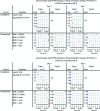Competing isogenic Campylobacter strains exhibit variable population structures in vivo
- PMID: 18424530
- PMCID: PMC2446568
- DOI: 10.1128/AEM.02835-07
Competing isogenic Campylobacter strains exhibit variable population structures in vivo
Abstract
Consumption of poultry contaminated with Campylobacter jejuni is a risk factor for human gastrointestinal disease. The rational development of control strategies for Campylobacter within chickens requires an understanding of the colonization process at the molecular and population levels, both within and between hosts. Experiments employing competing strains of Campylobacter have been used to investigate colonization. Implicit in these studies is the assumption that the behavior of competing strains is reproducible between experiments. Variability in the recovery of mutants from the chicken gastrointestinal tract during signature-tagged mutagenesis studies demonstrated that this is not always the case. To further investigate this phenomenon in the absence of confounding factors due to phenotypic differences between mutants, we constructed individually identifiable wild-type isogenic tagged strains (WITS) that have indistinguishable phenotypes in pure culture. By using mixtures of WITS, it is possible to monitor the relative amounts of subpopulations of essentially wild-type bacteria. Using a 2-week-old chicken model of colonization, we observed unpredictable variations in population structure both within and between experiments, even in the simplest case of two competing strains. This variation occurred both when birds were simultaneously infected with two WITS and when birds inoculated with different WITS were cohoused. We present evidence for founder effects during initial colonization with subsequent bird-to-bird transmission. We suggest that these and phenotypic variation contribute to the observed variability. These factors render simple models of colonization which do not take them into account inappropriate for Campylobacter and impact the planning and interpretation of competition experiments using this organism.
Figures



Similar articles
-
Signature-tagged transposon mutagenesis studies demonstrate the dynamic nature of cecal colonization of 2-week-old chickens by Campylobacter jejuni.Appl Environ Microbiol. 2005 Dec;71(12):8031-41. doi: 10.1128/AEM.71.12.8031-8041.2005. Appl Environ Microbiol. 2005. PMID: 16332783 Free PMC article.
-
Campylobacter colonization of the chicken induces a proinflammatory response in mucosal tissues.FEMS Immunol Med Microbiol. 2008 Oct;54(1):114-21. doi: 10.1111/j.1574-695X.2008.00458.x. Epub 2008 Jul 18. FEMS Immunol Med Microbiol. 2008. PMID: 18647351
-
Role of Campylobacter jejuni potential virulence genes in cecal colonization.Avian Dis. 2001 Jul-Sep;45(3):549-57. Avian Dis. 2001. PMID: 11569726
-
Colonisation phenotype and colonisation potential differences in Campylobacter jejuni strains in chickens before and after passage in vivo.Vet Microbiol. 2003 Apr 2;92(3):225-35. doi: 10.1016/s0378-1135(02)00378-4. Vet Microbiol. 2003. PMID: 12523984
-
Campylobacter jejuni colonization and transmission in broiler chickens: a modelling perspective.J R Soc Interface. 2007 Oct 22;4(16):819-29. doi: 10.1098/rsif.2007.1015. J R Soc Interface. 2007. PMID: 17472905 Free PMC article. Review.
Cited by
-
Effects of sequential Campylobacter jejuni 81-176 lipooligosaccharide core truncations on biofilm formation, stress survival, and pathogenesis.J Bacteriol. 2010 Apr;192(8):2182-92. doi: 10.1128/JB.01222-09. Epub 2010 Feb 5. J Bacteriol. 2010. PMID: 20139192 Free PMC article.
-
A sequencing-based method for quantifying gene-deletion mutants of bacteria in the intracellular environment.Front Microbiol. 2025 Jan 28;15:1487724. doi: 10.3389/fmicb.2024.1487724. eCollection 2024. Front Microbiol. 2025. PMID: 39981033 Free PMC article.
-
Mechanisms of biodiversity between Campylobacter sequence types in a flock of broiler-breeder chickens.Ecol Evol. 2022 Mar 6;12(3):e8651. doi: 10.1002/ece3.8651. eCollection 2022 Mar. Ecol Evol. 2022. PMID: 35342550 Free PMC article.
-
Campylobacter jejuni: targeting host cells, adhesion, invasion, and survival.Appl Microbiol Biotechnol. 2023 May;107(9):2725-2754. doi: 10.1007/s00253-023-12456-w. Epub 2023 Mar 21. Appl Microbiol Biotechnol. 2023. PMID: 36941439 Free PMC article. Review.
-
Evaluation of Glycosylated FlpA and SodB as Subunit Vaccines Against Campylobacter jejuni Colonisation in Chickens.Vaccines (Basel). 2020 Sep 11;8(3):520. doi: 10.3390/vaccines8030520. Vaccines (Basel). 2020. PMID: 32932979 Free PMC article.
References
-
- Adkin, A., E. Hartnett, L. Jordan, D. Newell, and H. Davison. 2006. Use of a systematic review to assist the development of Campylobacter control strategies in broilers. J. Appl. Microbiol. 100:306-315. - PubMed
Publication types
MeSH terms
Substances
Associated data
- Actions
Grants and funding
- BB/C500852/1/BB_/Biotechnology and Biological Sciences Research Council/United Kingdom
- BB/C500936/1/BB_/Biotechnology and Biological Sciences Research Council/United Kingdom
- BB/500852/1/BB_/Biotechnology and Biological Sciences Research Council/United Kingdom
- BB/500936/1/BB_/Biotechnology and Biological Sciences Research Council/United Kingdom
LinkOut - more resources
Full Text Sources
Medical

